
“Work Makes You Free”
Sachsenhausen was a Nazi concentration camp 30 km north of Berlin and was used from 1936 to the end of the Third Reich in 1945. Its close proximity to the capital gave it special status as the place to train camp guards and test new procedures. It was designed as a model camp and became one of the most notorious concentration camps of the Third Reich. It was also the site of the Third Reich’s massive counterfeiting operation, Operation Bernhard, in which inmates artisans were forced to produce forged American and British currency. This was one of the largest counterfeiting operations in history and was designed to undermine the British and United States’ economies during the war. Operation Bernhard was depicted in the Oscar-winning 2007 movie The Counterfeiters. Visiting this camp has the most gut wrenching rip at the soul and it is almost unbearable to bear witness to the absolute atrocities that were committed during this horrible era of the Third Reich.
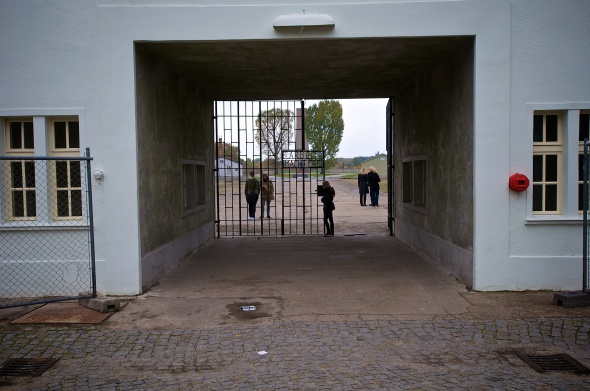
Prisoner’s entrance, “Tower A”
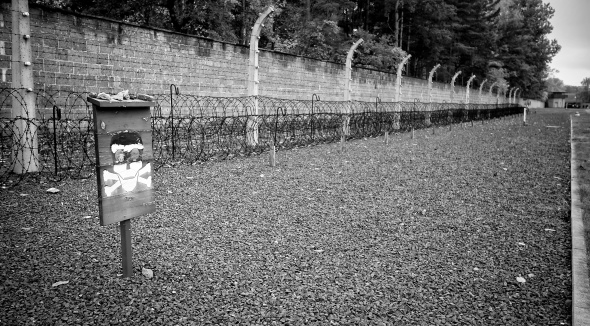
Death Strip
There were few successful escapes. The perimeter consisted of a 3m high wall. Within that there was a space that was patrolled by guards and dogs. This was bordered on the inside by a lethal electric fence; inside that was a gravel “death strip” forbidden to the prisoners. Any prisoner venturing onto the “death strip” would be shot by the guards without warning. Rewards such as extra leave were offered to guards who successfully shot and killed any prisoner who entered onto the death zone. Ultimately, too many prisoners decided to “escape” by suicide by stepping into the “death strip”, so the guards were then ordered to “shot to maim” rather than “shoot to kill”. The maimed were then further tortured.
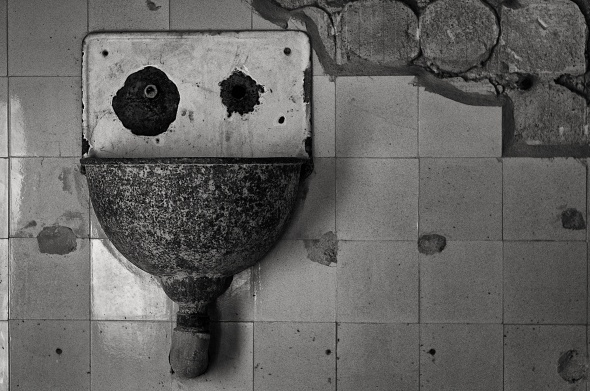 Sink in the Pathology Building and Cellar Mortuary.
Sink in the Pathology Building and Cellar Mortuary.

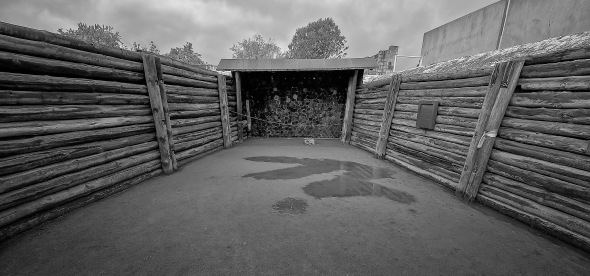 Execution Trench
Execution Trench
Used mostly but not exclusively for execution by gunfire of prisoners sentenced to death by the National Socialist courts. This was also the site of a gallows that could hang three people at a time.

Crematorium Oven
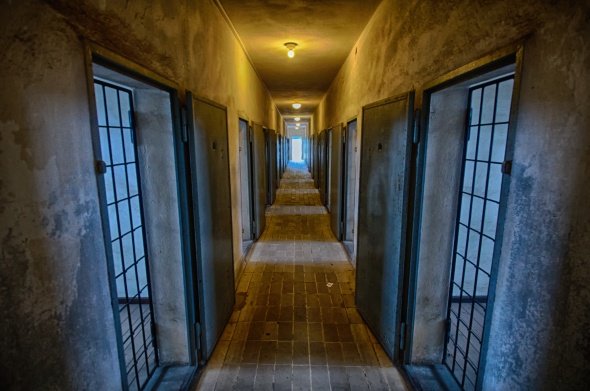
Prison Building
The Prison Building within the camp was built in 1936 and was used as a prison and by the gestapo for additional purposes. The prison was a place of secrets, abuse, and murder. The SS used the building to house camp prisoners but also other special prisoners sent from outside of the camp that the SS wished to isolate.
November 9, 2015 | Categories: Photography, Street Photography, Travel | Tags: B&W, Berlin, Germany, HDR, Nikon D90, photography, Silver Efex Pro, Street Photography, Travel and Tourism | 3 Comments

Ghost Stations of Berlin.
The Berlin Wall, constructed in August 1961, divided not only the city of Berlin into East and West, but also many of the underground U- and S- Bahn subway lines. While many of these lines now simply stopped at the borders, other lines which were primarily in the West now passed through a short segment of East Berlin. These lines remained open to the West Berliners, however they no longer stopped in East Berlin. They did, however, need to slow to a crawl as they passed through the now “Ghost Stations” (Geisterbahnhöfe) of East Berlin. Passengers would now pass through spooky, dimly lit, abandoned stations that were heavily guarded by East German guards who watched them slowly pass.
These stations were reopened in 1989 after the fall of the Wall. Entering the stations in ’89 (and now) was like stepping into a time machine and entering Cold War-era East Berlin, with the stations looking like they did when constructed in 1931 with original ads and signage as well as old green drab tiles on the walls. Most have now been totally refurbished. This shot was taken in the Alexanderplatz station in 2013.
October 21, 2015 | Categories: Street Photography, Travel | Tags: Berlin, Germany, ghost, HDR, Nazi, Nikon D90, photography, Street Photography, Travel and Tourism | 2 Comments


Memorial to the Murdered Jews of Europe, Berlin
Consisting of 2,711 gravestone-like pillars ranging in height from 0.2 to 4.8 m (7.9 in to 15 ft 9.0 in) and arranged in a grid pattern on a sloping field, this memorial was completed in 2005 and was the first formal German government-sponsored Holocaust memorial. Maintaining the word “murdered” in the title was intentional, as Germany as a nation was finally officially admitting to a crime.
There is no intended meaning. Instead, the memorial was designed to instill in the viewer a confusing and uneasy feeling. Is it a labyrinth? a symbolic cemetery? It’s up to the you to derive the meaning while pondering this horrible chapter in human history.
October 20, 2015 | Categories: Photography, Street Photography, Travel | Tags: Autumn, Berlin, Germany, HDR, Holocaust, Nazi, Nikon D90, photography, Street Photography, Travel and Tourism | 2 Comments

Autumn at The Brandenberg Gate, Berlin
The Brandenburg Gate (1791), is an 18th-century neoclassical triumphal arch and the grandest and last survivor of the 14 original arches of Berlins Old City Wall. It is crowned with a four Horse chariot with the Goddess of Peace at the reins. During its existence, it has often been a site for major historical events
When the Nazis ascended to power, they used the gate as a party symbol. The gate was heavily damaged during World War II and was one of the last structures still standing in the Pariser Platz in 1945.
Traffic passed freely through the gate until the Berlin Wall was built Aug 1961. During post-war Partition of Germany, the now East Berlin gate was isolated and inaccessible adjacent to the Berlin Wall. In June of 1987, Ronald Reagan gave a speech at the Brandenberg Gate and challenged Soviet leader Mikhail Gorbachev to “Tear down this wall!”
When the Revolutions of 1989 occurred and the Berlin Wall fell Nov,1989, the gate symbolized freedom and the desire to unify Berlin. Thousands gathered there to celebrate its fall. Today it is considered a symbol of the tumultuous history of Europe and Germany, but also of European unity and peace.
October 16, 2015 | Categories: Photography, Street Photography, Travel | Tags: Autumn, Berlin, Clouds, Germany, HDR, Nikon D90, photography, Street Photography, Travel and Tourism, World Heritage Site | 3 Comments

Autumn at the Reichstag Building, Berlin
The Reichstag Building opened in 1894 as the house of the German Parliment. The building was nearly burned to the ground in 1933 by arsonists, an event that the Nazi party used as evidence that communists were conspiring against the German Government. Adolf Hitler, then the Chancellor of Germany, used this to convince the German President to pass an emergency decree suspending all civil liberties of the German people, ultimately leading to the consolidation of power by Hitler and the Nazi party. Many believe that Hitler himself orchestrated the blaze.
October 13, 2015 | Categories: Street Photography, Travel | Tags: Autumn, Berlin, Fall, Germany, HDR, Nikon D90, photography, Street Photography, Travel and Tourism, World Heritage Site | 2 Comments

Autumn in Prenzlauer Berg, Berlin
Prenzlauer Berg is a district in the former East Berlin which survived the bombings of WWII relatively unscathed, allowing it’s giant Industrail Age buildings to survive the war, only to rot away under the communist rule of East Berlin. After the fall of the Berlin Wall, Prenzlauer Berg became a primary destination for the hipsters, artists, and entrepreneurs given its cheap housing and unique urban planning and architecture. It is now one of Berlin’s most beautiful neighborhoods, stuffed with pubs, restaurants, cafes, galleries and shops that provide a vibrant atmosphere both day and night.
This shot was taken on the grounds of the Wasserturm Prenzlauer Berg, Berlins oldest water tower, completed in 1877 and used until 1952.
September 26, 2015 | Categories: Photography, Street Photography, Travel | Tags: Autumn, Berlin, Fall, Germany, photography, Street Photography, Travel and Tourism | 4 Comments

Autumn in Berlin
Berlin, Germany is a city that has three distinct personalities. The first is tied to its role in Nazi Germany/Third Reich (1933-45), in which Germany was a fascist totalitarian state under Adolf Hitler that controlled all aspects of life and whose central feature was the Holocaust (11 million murdered, 6 m Jews, 5 m non-jews). Second, there is Cold War East Berlin (1949-90) and the Berlin Wall (1961-89), the Soviet communist sector of Berlin established after WWII, and finally the “New” Berlin, a city that has and continues to develop into a vibrant, gritty, eclectic city which has become a must see destination for foodies, partiers, and music/art/culture lovers the world over.
What follows is a selection of pics I took in Oct 2013 during a (much too) short family visit to Berlin. Hopefully we will get back there soon.
September 24, 2015 | Categories: Photography, Street Photography, Travel | Tags: Berlin, Germany, Night, photography, Street, Street Photography, Travel and Tourism, World Heritage Site | 2 Comments
 Sink in the Pathology Building and Cellar Mortuary.
Sink in the Pathology Building and Cellar Mortuary.















